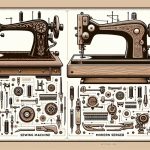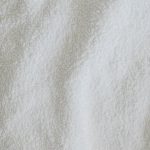So, you're in the market for a new serger, and the age-old debate of Brother vs. Singer is at the forefront of your decision-making process.
We've all been there, trying to weigh the pros and cons of each brand, hoping to make the right choice.
But what if I told you there's more to consider than just the name on the machine?
Let's dive into the nitty-gritty details that set these two sergers apart and help you make an informed decision that suits your sewing needs perfectly.
Table of Contents
Key Takeaways
- Brother serger offers precise thread control and adjustable settings.
- Singer serger excels in differential feed for smooth fabric handling.
- Brother emphasizes stitch quality and user-friendly design.
- Singer focuses on speed with potential durability concerns.
Key Features Comparison
When comparing the key features of the Brother and Singer sergers, one can easily distinguish the distinct advantages each machine offers. Thread tension and differential feed are vital elements that set these sergers apart.
To start, the Brother serger provides precise control over thread tension. With easily adjustable settings, users can guarantee that the threads are perfectly balanced, resulting in neat and professional finishes on their projects. This feature is particularly beneficial when working with different fabric types that require varying thread tensions for best results.
On the other hand, the Singer serger excels in the differential feed functionality. This feature allows for smooth and even fabric feeding, preventing stretching or puckering, especially when working with stretchy or slippery fabrics. The ability to adjust the feed ratio ensures that the fabric is fed through the machine evenly, resulting in high-quality seams and edges.
Stitching Capabilities Breakdown
Let's talk about the stitching capabilities of these sergers.
The stitch types each machine offers can greatly impact the versatility of your projects.
Additionally, exploring the built-in features will help you understand the range of functions each serger provides.
Stitch Types
Comparing the stitch types of the Brother and Singer sergers reveals distinct differences in their stitching capabilities.
- Thread Tension & Stitch Length: Both the Brother and Singer sergers offer adjustable thread tension and stitch length, allowing for precise control over the tightness and length of stitches.
- Stitch Width & Differential Feed: While both machines provide adjustable stitch width settings, the Singer serger excels in offering a wider range of stitch widths. Additionally, the Singer serger typically provides more advanced differential feed options, allowing for smoother and more professional results when working with different fabric types.
These differences in stitch types between the Brother and Singer sergers can have a significant impact on the versatility and quality of the stitches produced.
Built-in Features
In exploring the built-in features of both the Brother and Singer sergers, we uncover a detailed breakdown of their stitching capabilities.
When it comes to thread tension, both machines offer adjustable settings to guarantee smooth and balanced stitches. The Brother serger provides a user-friendly system for fine-tuning thread tension, while the Singer serger offers a precise adjustment mechanism for different types of fabrics.
Additionally, the Brother serger excels in differential feed functionality, allowing for consistent stitching on various fabric thicknesses. On the other hand, the Singer serger boasts a differential feed feature that enables smooth fabric handling and prevents stretching or puckering.
Understanding these built-in features is essential for mastering the full potential of these sergers in your sewing projects.
User-Friendliness Assessment
When evaluating user-friendliness between Brother and Singer sergers, one can easily discern the differences in their ease of operation. Here are four key points to contemplate:
- Ease of Use: Brother sergers are often praised for their intuitive design, making them user-friendly even for beginners. Singer sergers, on the other hand, may have a steeper learning curve due to their slightly more complex setup.
- Learning Curve: Brother sergers tend to have a smoother learning curve, with clear instructions and user-friendly features that help users grasp the machine's functions quickly. Singer sergers may require a bit more time and practice to master, especially for those new to serging.
- User Interface: Brother sergers typically have a more straightforward user interface, with easily accessible controls and settings. In comparison, Singer sergers might've a more intricate interface that could be overwhelming for some users initially.
- Support and Resources: Brother often provides extensive support materials and online resources, including tutorials and FAQs, which can significantly aid users in mastering their sergers. Singer also offers support but may have fewer resources available compared to Brother.
Built Quality Evaluation
I'll kick off the built quality evaluation by comparing the material durability of the Brother and Singer sergers.
Then, I'll investigate how precise the stitching is on both machines.
Material Durability Comparison
Comparing the material durability of the Brother and Singer sergers reveals distinct differences in their built quality.
- Brother Serger: The Brother serger is constructed with a sturdy metal frame that enhances its overall durability. This robust build guarantees longevity even with frequent use.
- Singer Serger: On the other hand, the Singer serger is primarily made of plastic components, which may not offer the same level of durability as the metal frame of the Brother serger.
- Thread Tension Components: The Brother serger incorporates high-quality thread tension components that contribute to its durability over time, reducing the need for frequent adjustments.
- Knife Mechanism: The Singer serger's knife mechanism, although efficient, may be more prone to wear and tear compared to the Brother serger's sturdier design.
Stitching Precision Assessment
Evaluating the stitching precision of both sergers provides valuable insights into their built quality and performance. Thread tension plays a critical role in achieving neat and secure stitches. The ability to adjust the thread tension easily and effectively can greatly impact the overall stitching quality.
Additionally, stitch length is another important factor that influences the appearance and durability of seams. A serger that allows for precise control over stitch length enables the user to customize their projects according to specific requirements.
Engineering Design Examination
In evaluating the engineering design of sergers, the focus lies on evaluating the built quality to determine their durability and performance capabilities.
- Material Durability: Inspecting the quality of materials used in the construction to make sure longevity and resistance to wear and tear.
- Precision Engineering: Examining how well components fit together and operate smoothly for consistent and reliable performance.
- Incorporation of Technology Advancements: Analyzing how modern technological features are integrated to enhance functionality and user experience.
- Adaptation to Market Trends: Considering how the serger design aligns with current market demands and consumer preferences for efficient and innovative stitching solutions.
Price Point Analysis
After conducting a thorough analysis of the price points of the Brother and Singer sergers, it became evident that the Brother model offers a more cost-effective option for those on a budget. When comparing price points, the Brother serger tends to be more affordable than its Singer counterpart. Despite both brands having a solid reputation in the sewing industry, the cost-effectiveness of the Brother serger makes it an attractive choice for those looking to balance quality and affordability.
Below is a table providing a snapshot of the price points of the Brother and Singer sergers:
| Aspect | Brother Serger | Singer Serger |
|---|---|---|
| Price Range | $200-$400 | $300-$500 |
| Entry-Level Model | $200 | $300 |
| High-End Model | $400 | $500 |
Performance and Speed Comparison
When comparing the performance and speed of the Brother and Singer sergers, one can quickly notice distinct differences that impact the overall sewing experience.
- Stitch Quality: The Brother serger offers more consistent stitch quality compared to the Singer, providing cleaner and more professional-looking finishes on a variety of fabrics.
- Speed: Concerning speed, the Singer serger tends to be faster than the Brother, making it a preferred choice for projects that require quick completion without compromising quality.
- Thread Tension Control: The Brother serger excels in thread tension control, allowing for precise adjustments that result in neater seams and reduced likelihood of thread breakage during high-speed sewing.
- Noise Level: While both sergers produce some level of noise during operation, the Brother serger tends to be quieter than the Singer, offering a more pleasant sewing experience, especially during long sewing sessions.
Warranty and Support Comparison
Comparing the performance and speed of the Brother and Singer sergers highlighted key differences; now, let's shift focus to the Warranty and Support Comparison. When it comes to warranty coverage, both Brother and Singer offer varying terms. Brother typically provides a 25-year limited warranty on their sergers, which covers defects in materials and workmanship. On the other hand, Singer sergers often come with a 90-day limited warranty that protects against defects. Notably, warranty lengths can differ based on the model and region, so checking the specifics is crucial.
Regarding customer service, Brother is known for its responsive and helpful support team. They offer assistance through phone, email, and live chat, making it convenient for users to get help when needed. Singer also provides customer service via multiple channels, although some users have reported longer wait times for responses compared to Brother. When deciding between the two brands, considering the warranty coverage and customer service support offered can be pivotal factors in making a well-informed choice.
Final Verdict: Which to Choose?
So, which serger should you choose: Brother or Singer? After a thorough comparison of these two popular brands, here is the final verdict to help you make an informed decision:
- Performance: Brother sergers are known for their smooth and efficient performance, making them ideal for both beginners and experienced users. On the other hand, Singer sergers offer reliable performance with a focus on durability and precision stitching.
- Features: Brother sergers often come equipped with advanced features such as differential feed and easy threading systems, enhancing user experience. Singer sergers, on the other hand, focus on essential features that cater to the basic needs of a serger user.
- Price: When it comes to pricing, Brother sergers are generally more budget-friendly, offering great value for money. Singer sergers, while slightly pricier, are known for their durability and long-term reliability.
- Overall Verdict: If you're looking for a reliable serger with advanced features at a reasonable price, Brother sergers might be the best choice for you. However, if durability and precision stitching are your top priorities, Singer sergers could be the ideal option.
Frequently Asked Questions
Can the Brother or Singer Serger Handle Heavy-Duty Fabrics Like Denim or Canvas?
Handling heavy-duty fabrics like denim or canvas is a breeze with both the Brother and Singer sergers. The stitch quality remains impeccable, and speed control allows efficient sewing. These sergers can tackle tough materials with ease.
How Easy Is It to Change the Settings on the Brother or Singer Serger for Different Types of Stitches?
Changing settings on my serger for different stitches is straightforward. I adjust stitch precision easily, control speed smoothly, fine-tune thread tension effortlessly, and manage the differential feed seamlessly. Mastering these elements enhances my sewing experience.
Are There Any Additional Accessories or Attachments Available for the Brother or Singer Serger?
There are numerous additional accessories and attachments available for my serger, enhancing its functionality and versatility. I enjoy exploring their compatibility and how they expand the machine's stitching capabilities beyond its original limitations.
Can the Brother or Singer Serger Be Used for Decorative Stitching or Embellishments?
Absolutely! I love using my serger for creative possibilities. It's fantastic for decorative stitching and embellishment techniques. I enjoy experimenting with unique designs, adding flair to my projects. The serger truly elevates my sewing game!
How Noisy Is the Operation of the Brother or Singer Serger Compared to Traditional Sewing Machines?
Operating my serger is surprisingly quiet compared to traditional sewing machines. Regular maintenance keeps it running smoothly. When compared, the serger's efficiency in noise level is a pleasant surprise, making it ideal for late-night projects.
- Is Acetate Fabric Flammable? A Critical Safety Guide - June 24, 2025
- How to Safely Whiten Yellowed or Stained Acetate Fabric at Home - June 24, 2025
- Can You Dry Clean Acetate? Everything You Need to Know - June 24, 2025






